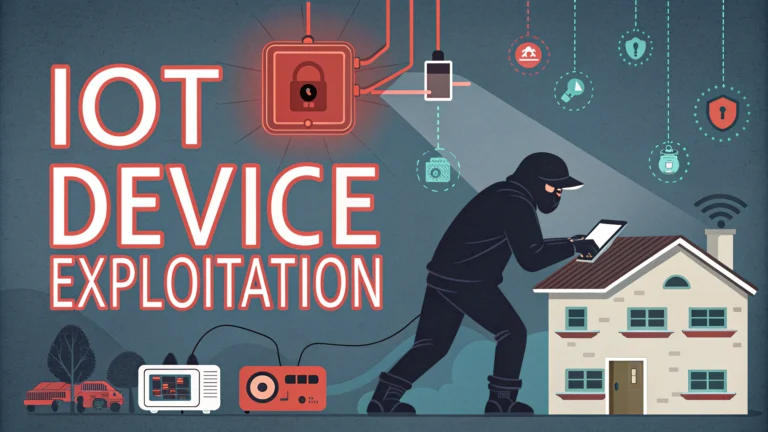IoT device exploitation has become a critical security concern as more devices connect to networks and the internet.
Security professionals need practical skills to identify and test IoT vulnerabilities before malicious actors can exploit them.
This guide covers essential IoT penetration testing techniques, tools, and methodologies used by security experts to evaluate device security.
Getting Started with IoT Penetration Testing
A proper IoT security assessment requires both hardware and software testing capabilities.
- Network analyzers (Wireshark, tcpdump)
- Protocol analyzers
- Hardware debugging tools
- Firmware extraction tools
- Vulnerability scanners
Common IoT Attack Vectors
- Default credentials
- Unencrypted communications
- Firmware vulnerabilities
- API security flaws
- Physical security weaknesses
- Network protocol exploits
Testing Methodology
- Information Gathering
- Device identification
- Network mapping
- Protocol analysis
- Firmware version detection
- Vulnerability Assessment
- Port scanning
- Service enumeration
- Known vulnerability checking
- Configuration review
- Exploitation
- Password attacks
- Buffer overflow testing
- Protocol fuzzing
- Command injection
Essential Tools for IoT Testing
| Tool | Purpose |
|---|---|
| Nmap | Network scanning and device discovery |
| Binwalk | Firmware analysis and extraction |
| Metasploit | Exploitation framework |
| Bus Pirate | Hardware debugging |
| Burp Suite | Web interface testing |
Hardware Security Testing
Physical device security testing requires specialized equipment and knowledge.
- UART/JTAG debugging
- Side-channel analysis
- Voltage glitching
- Memory extraction
Firmware Analysis
Firmware analysis can reveal hardcoded credentials, encryption keys, and vulnerable code.
- Extract firmware using chip readers or update files
- Analyze extracted filesystem
- Identify security mechanisms
- Look for sensitive information
Network Security Testing
Network testing focuses on communication protocols and data transmission security.
- Bluetooth Low Energy (BLE) testing
- Wi-Fi security assessment
- Zigbee protocol analysis
- MQTT security testing
Reporting and Documentation
Document findings with clear evidence and remediation recommendations.
- Vulnerability details
- Proof of concept code
- Risk assessment
- Mitigation strategies
Moving Forward with IoT Security
Regular security assessments help maintain IoT device security posture.
Stay updated with new IoT vulnerabilities and testing techniques through resources like IoT Security Foundation.
Consider certification programs like GIAC GWEB or Offensive Security OSWP to enhance IoT security testing skills.
Best Practices for IoT Security Assessment
- Establish a systematic testing methodology
- Document all findings thoroughly
- Maintain up-to-date testing tools
- Follow responsible disclosure practices
- Consider legal and regulatory requirements
Advanced IoT Testing Techniques
Cloud Integration Testing
- API endpoint security
- Data storage security
- Authentication mechanisms
- Access control testing
Mobile Application Testing
- App decompilation analysis
- Authentication bypass testing
- Session management
- Data transmission security
Automated Testing Solutions
- Continuous security scanning
- Automated vulnerability assessment
- Compliance checking tools
- Device monitoring systems
Building Secure IoT Ecosystems
Implementing comprehensive security testing is crucial for maintaining robust IoT environments.
- Regular security assessments
- Continuous monitoring
- Incident response planning
- Security awareness training
- Vendor security evaluation
Join professional IoT security communities and participate in vulnerability research to stay ahead of emerging threats.
Remember that IoT security is an ongoing process requiring constant vigilance and adaptation to new attack vectors.
FAQs
- What are the primary attack vectors for IoT devices?
Default credentials, unencrypted communications, firmware vulnerabilities, insecure web interfaces, and weak authentication mechanisms are the main attack vectors. - Which tools are commonly used for IoT penetration testing?
Nmap, Wireshark, Metasploit, Shodan, Firmware Analysis Toolkit (FAT), and BurpSuite are essential tools for IoT device testing. - How do you perform firmware analysis on IoT devices?
Extract the firmware using methods like JTAG, analyze binary files with tools like Binwalk, perform static analysis, and examine file systems for hardcoded credentials and security flaws. - What protocols should be tested during IoT penetration testing?
MQTT, CoAP, ZigBee, Z-Wave, Bluetooth Low Energy (BLE), and traditional TCP/IP protocols need to be tested for vulnerabilities. - How can you detect vulnerable IoT devices on a network?
Use network scanning tools like Nmap, employ Shodan for internet-connected devices, analyze network traffic with Wireshark, and conduct port scanning. - What are common IoT device authentication vulnerabilities?
Weak passwords, hardcoded credentials, lack of multi-factor authentication, unsecured password recovery mechanisms, and insufficient session management. - How do you test IoT device communication security?
Analyze traffic encryption, check for SSL/TLS implementation, test for man-in-the-middle vulnerabilities, and verify secure key exchange mechanisms. - What physical security aspects should be tested on IoT devices?
Debug ports accessibility, hardware interfaces security, anti-tamper mechanisms, secure boot implementation, and physical memory extraction possibilities. - How can you test IoT device firmware update mechanisms?
Check for signed updates, verify secure transmission of updates, test rollback protection, and analyze update verification procedures. - What are the legal considerations for IoT penetration testing?
Obtain proper authorization, comply with relevant regulations like GDPR or CCPA, document testing scope, and ensure testing doesn’t violate manufacturer warranties.







